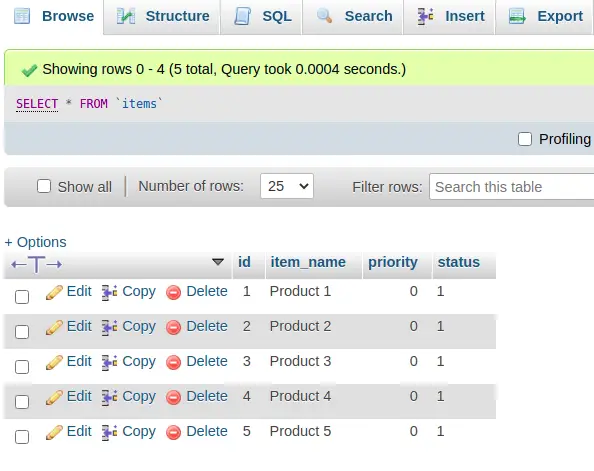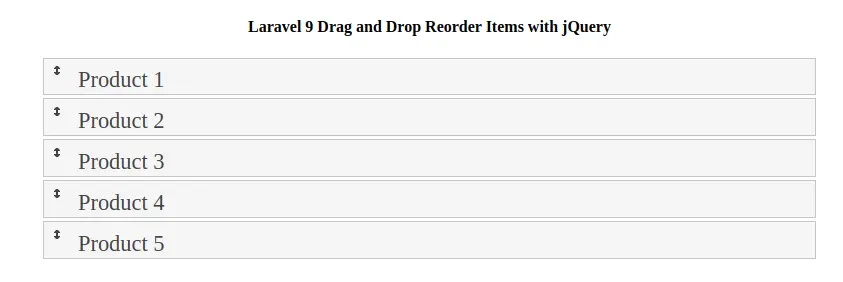Inside this article we will see the concept i.e Laravel 9 Drag and Drop Reorder Items with jQuery Tutorial. Article contains the classified information about Sorting MySQL Row Order using jQuery.
If you are looking for a solution i.e Drag & Drop Reorder Items in Laravel then this article will help you a lot for this. Tutorial is super easy to understand and implement it in your code as well.
We will see drag, drop and sort concept using Laravel & jQuery UI. We will use sorting function of jquery ui.
Learn More –
- How To Use Froala WYSIWYG HTML Editor in PHP Tutorial
- CodeIgniter 4 How To Use Froala WYSIWYG HTML Editor Tutorial
- CodeIgniter 4 Autocomplete Places Search Box Using Google Maps JavaScript API
- PHP & MySQLi Drag and Drop Reorder Items with jQuery
Let’s get started.
Laravel Installation
Open terminal and run this command to create a laravel project.
composer create-project laravel/laravel myblogIt will create a project folder with name myblog inside your local system.
To start the development server of laravel –
php artisan serveURL: http://127.0.0.1:8000
Assuming laravel already installed inside your system.
Create Database & Connect
To create a database, either we can create via Manual tool of PhpMyadmin or by means of a mysql command.
CREATE DATABASE laravel_app;
To connect database with application, Open .env file from application root. Search for DB_ and update your details.
DB_CONNECTION=mysql DB_HOST=127.0.0.1 DB_PORT=3306 DB_DATABASE=laravel_app DB_USERNAME=root DB_PASSWORD=root
Create Migration
Open project into terminal and run this command to create migration file.
$ php artisan make:migration create_items_tableIt will create a file –
- Migration file – xxx_create_items_table.php inside /database/migrations folder.
Open Migration file and write this complete code into it.
<?php
use Illuminate\Database\Migrations\Migration;
use Illuminate\Database\Schema\Blueprint;
use Illuminate\Support\Facades\Schema;
return new class extends Migration
{
/**
* Run the migrations.
*
* @return void
*/
public function up()
{
Schema::create('items', function (Blueprint $table) {
$table->id();
$table->string("item_name", 50);
$table->integer("priority")->default(0);
$table->enum("status", [1, 0])->default(1);
});
}
/**
* Reverse the migrations.
*
* @return void
*/
public function down()
{
Schema::dropIfExists('items');
}
};
Run Migration
Next,
We need to create table inside database.
$ php artisan migrateThis command will create table – items inside database.
Let’s insert some Test data into this table.
Execute this sql query into database for fake rows.
INSERT INTO `items` (`id`, `item_name`, `priority`, `status`) VALUES
(1, 'Product 1', 0, '1'),
(2, 'Product 2', 0, '1'),
(3, 'Product 3', 0, '1'),
(4, 'Product 4', 0, '1'),
(5, 'Product 5', 0, '1');

Create Model & Controller
Next,
We need to create a model and a controller file.
$ php artisan make:model Item -cIt will create a model Item.php inside /app/Models folder and also a controller ItemController.php inside /app/Http/Controllers folder.
Open ItemController.php and write this complete code into it.
<?php
namespace App\Http\Controllers;
use Illuminate\Http\Request;
use App\Models\Item;
class ItemController extends Controller
{
public function index()
{
$items = Item::orderBy('priority')->get();
return view("items", compact("items"));
}
public function updateOrder(Request $request)
{
$input = $request->all();
if (isset($input["order"])) {
$order = explode(",", $input["order"]);
for ($i = 0; $i < count($order); $i++) {
Item::where('id', $order[$i])->update(['priority' => $i]);
}
return json_encode([
"status" => true,
"message" => "Order updated"
]);
}
}
}
Update Model
Open model file Item.php from /app/Models folder.
<?php
namespace App\Models;
use Illuminate\Database\Eloquent\Factories\HasFactory;
use Illuminate\Database\Eloquent\Model;
class Item extends Model
{
use HasFactory;
public $timestamps = false;
}
Create Blade Template File
Go to /resources/views folder and create a file with name items.blade.php
Open items.blade.php and write this complete code into it.
<!doctype html>
<html lang="en">
<head>
<meta charset="utf-8">
<meta name="csrf-token" content="{{ csrf_token() }}" />
<meta name="viewport" content="width=device-width, initial-scale=1">
<title>Laravel 9 Drag and Drop Reorder Items with jQuery</title>
<link rel="stylesheet" href="//code.jquery.com/ui/1.13.1/themes/base/jquery-ui.css">
<style>
#sortable {
list-style-type: none;
margin: 0 auto;
padding: 0;
width: 60%;
}
#sortable li {
margin: 0 3px 3px 3px;
padding: 0.4em;
padding-left: 1.5em;
font-size: 1.4em;
height: 18px;
}
#sortable li span {
position: absolute;
margin-left: -1.3em;
}
</style>
</head>
<body>
<h4 style="text-align: center;">Laravel 9 Drag and Drop Reorder Items with jQuery</h4>
<ul id="sortable">
@if (count($items) > 0)
@foreach ($items as $row)
<li class="ui-state-default" id="<?php echo $row->id; ?>"><span class="ui-icon ui-icon-arrowthick-2-n-s"></span><?php echo $row->item_name; ?></li>
@endforeach
@endif
</ul>
<script src="https://code.jquery.com/jquery-3.6.0.js"></script>
<script src="https://code.jquery.com/ui/1.13.1/jquery-ui.js"></script>
<script>
$(function() {
$.ajaxSetup({
headers: {
'X-CSRF-TOKEN': $('meta[name="csrf-token"]').attr('content')
}
});
$("#sortable").sortable({
update: function(event, ui) {
updateOrder();
}
});
});
function updateOrder() {
var item_order = new Array();
$('#sortable li').each(function() {
item_order.push($(this).attr("id"));
});
var order_string = 'order=' + item_order;
$.ajax({
type: "POST",
url: "{{ route('update-order') }}",
data: order_string,
cache: false,
success: function(data) {}
});
}
</script>
</body>
</html>
Add Route
Open web.php from /routes folder and add these route into it.
//...
use App\Http\Controllers\ItemController;
Route::get('items', [ItemController::class, "index"]);
Route::post('update-order', [ItemController::class, "updateOrder"])->name("update-order");
//...
Application Testing
Run this command into project terminal to start development server,
php artisan serveURL: http://127.0.0.1:8000/items
List of Items before sorting:

Drag & Sorted Items:

We hope this article helped you to learn Laravel 9 Drag and Drop Reorder Items with jQuery Tutorial in a very detailed way.
If you liked this article, then please subscribe to our YouTube Channel for PHP & it’s framework, WordPress, Node Js video tutorials. You can also find us on Twitter and Facebook.
